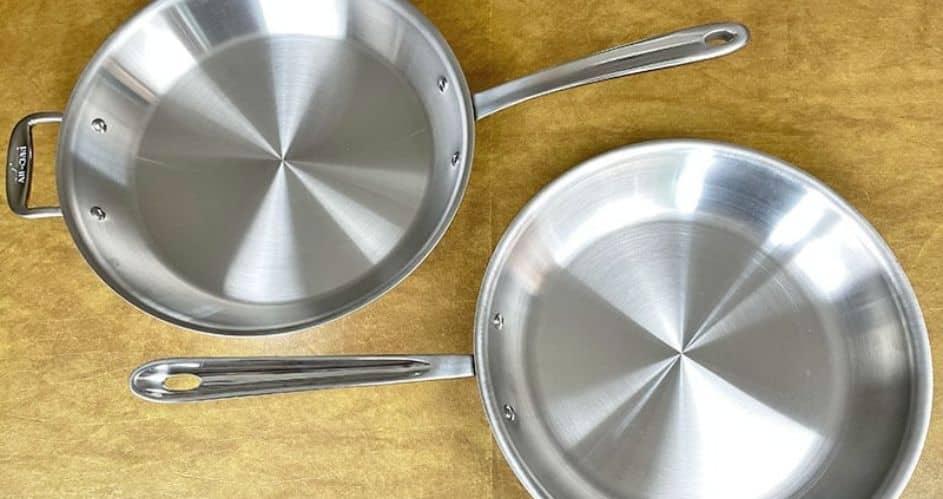
Two brands often come to mind when selecting high-quality cookware for your kitchen: All-Clad and Calphalon. Both brands are renowned for their durability, performance, and the variety of options they offer to culinary enthusiasts.
However, choosing between them can be a challenge. This comparison aims to highlight the key features, benefits, and differences between All-Clad and Calphalon, helping you make an informed decision that suits your cooking needs and preferences.
All-Clad vs. Calphalon: Factors On Which Their Cookware Compare
| Feature | All-Clad | Calphalon |
|---|---|---|
| Material Quality | High-grade stainless steel, often tri-ply | Quality stainless steel, variety in construction (tri-ply, non-stick) |
| Heat Distribution | Excellent, even heating due to tri-ply or multi-ply construction | Very good, depends on the line (tri-ply is best) |
| Durability | Extremely durable, lifetime warranty | Durable, warranties vary by product line |
| Price | Higher, premium pricing | More affordable, with a wide range depending on the collection |
| Cooktop Compatibility | Compatible with all cooktops, including induction | Generally compatible with all cooktops, specific non-stick lines may have restrictions |
| Product Range | Wide range of professional-grade cookware | Broad selection including non-stick, stainless steel, and more |
| Reputation & Reviews | Highly regarded by professional chefs and serious cooks | Well-reviewed, popular for home cooks looking for quality at a better price point |
This table encapsulates the distinct characteristics, offerings, and market positioning of All-Clad and Calphalon, providing a clear overview of what each brand is known for and whom it caters to within the cookware market.
Difference Between All Clad and Calphalon
Construction Materials and Techniques
All-Clad is best known for using high-quality stainless steel in a fully clad, multi-layer construction. This method involves bonding layers of stainless steel with either aluminium or copper to enhance heat distribution and retention. The construction extends throughout the entire pan, ensuring even cooking.
Calphalon is recognized for pioneering hard-anodized aluminium cookware, making it more durable and corrosion-resistant than standard aluminium. It also offers stainless steel cookware and is well-regarded for its non-stick surfaces, resulting from its focus on innovative coatings.
Product Offerings
All-Clad focuses predominantly on stainless steel cookware and has a smaller, more specialized product line. Its offerings cater to serious home cooks and professionals who require precise heat control and durability.
Calphalon has a broader range of products, including non-stick, stainless steel, and cast iron cookware. It offers more variety in cookware types and sets, appealing to a broader audience, from beginners to experienced cooks.
Price Points
All-Clad products are positioned in the premium segment of the market. The cost reflects the high-quality materials, construction techniques, and the brand’s reputation in professional kitchens.
Calphalon provides a wide range of price points, from more affordable options in the non-stick category to higher-priced items in its stainless steel collection. It makes Calphalon accessible to a broader audience, including those who are looking for quality cookware on a budget.
Target Market
All-Clad targets are cooking enthusiasts and professional chefs who prioritize top-tier performance and are willing to invest in cookware that offers longevity and superior heat management.
Calphalon appeals to a wide demographic, including novice cooks, families, and experienced home chefs looking for reliable, versatile cookware options that offer good value for money.
The primary differences between All-Clad and Calphalon lie in their choice of materials, construction methods, product diversity, pricing strategy, and target consumers.
All-Clad emphasizes premium stainless steel cookware with advanced heat distribution for severe culinary endeavours. At the same time, Calphalon offers a broader array of options, focusing on versatility, innovation in non-stick surfaces, and value across different cooking needs and budget ranges.
Customer Satisfaction and Reviews
The discussion on Food52 about All-Clad vs Calphalon reveals personal experiences and preferences. Users generally favour All-Clad for its quality and cooking performance, noting its heat distribution and durability superiority.
Some mention switching from Calphalon to All-Clad and not returning, highlighting All-Clad’s worth despite its higher price. However, Calphalon is recognized for specific uses, like stock pots, indicating that it might suit particular needs well.
The consensus leans towards investing in All-Clad of severe cooks, valuing its long-term performance and quality.
The discussion on ChefTalk about All-Clad vs. Calphalon cookware highlights personal experiences and preferences. Contributors generally note the durability and performance of All-Clad, with some pointing out that after many years, All-Clad pieces remain effective, whereas anodized Calphalon pieces may need replacement.
As mentioned by some, the ease of cleaning and maintaining stainless steel interiors tips the balance in favour of All-Clad for long-term investment in cookware.
However, there’s an acknowledgement that cookware choices can be subjective and depend on individual cooking styles and needs. For more detailed insights and personal experiences, you can read the discussion on ChefTalk.
Related Topic: All-Clad Metal Crafters’ Oven-Safe
Conclusion:
The critical difference between All-Clad and Calphalon lies in their construction quality, material composition, and price points. All-Clad is renowned for its superior heat distribution, durability, and performance, making it a favourite among professional chefs.
Calphalon offers a more affordable price range while still providing good quality and performance, which is suitable for everyday cooking and home kitchens. Choosing between the two depends on your cooking needs, budget, and preferences for cookware performance and longevity.